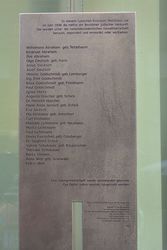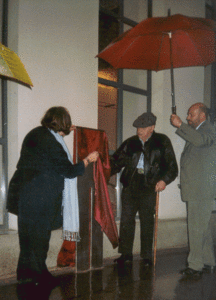Memorial Plaque at Servitengasse 6
The project "Servitengasse 1938 - Fates of those who Disappeared" began in house Servitengasse 6 as a private initiative. Around half the tenants of this house were of Jewish descent. When it become impossible to realise the initiative's original aim - to mount a plaque commemorating the victims of Nazi persecution directly onto the house itself - the district council, which supported the project, allowed the erection of a memorial on public ground. This was unveiled in a ceremony on 20 September 2005 by Martina Malyar, head of the district council, in the presence of a survivor from the house, Paul Lichtman.
Paul Lichtman's speech at the unveiling
I would like to thank everyone who has helped in bringing my son and me here for the dedication of this special plaque. I am sorry my wife could not come because of medical reasons.
Thank you also to the Jewish Welcome Service of Vienna - Dr. Zelman - , the Green Party for it's donation, and to Barbara Kintaert and her friends for researching this building and it's old occupants of 1938. Without them, my son and I would not have been able to attend this dedication.
I would also like to thank the mayor of the 9th Bezirk Alsergrund, Mrs. Martina Malyar, for allowing this plaque to be placed on the sidewalk in front of Servitengasse 6.
You all have fulfilled my dream of returning to beautiful Wien and to show my son all of the landmarks of his father's heritage. May we all see peace in our time, and thank you from the botton of my heart.
Heute bin ich ein Wiener and I am proud of it!
History of the House
The house at Servitengasse 6 is one of the more stately houses in the street. Previously the house on this site had been granted the rights to house a bakery and since the 18th century - possibly earlier - there has been a baker at Servitengasse 6. The current building, dating from 1904, has four stories and in the 1930 land registry is listed as containing five businesses and 23 apartments. In 1938, the starting point for the project's historical research, 12 apartments were listed as having Jewish tenants, and nine as having non-Jewish tenants. In one case it is unclear whether the tenant was of Jewish descent.
At the turn of the century, around a sixth of the residents in Vienna's 9th district were Jewish. Newcomers to the 9th district came mostly from Bohemia, Poland and southern Germany. The composition of the residents of Servitengasse 6 can also be described as being characteristic: a mixture of long-standing Vienna families and those who had come to Vienna from the old Habsburg Crown Lands after World War 1.
Evictions
Following the Nazi takeover of power in March 1938 there was seemingly great interest in rendering Servitengasse 6 "free of Jews" as quickly as possible, as the official term at the time put it. The first evictions started after November pogrom in 1938. Karl Krishaber, a businessman with a braces factory in Osijekt/Yugolsavia, had to leave his flat on November 10th and moved to a house in the 18th district that still belonged to himself and his sister at this time. Some residents were allowed to remain in their flats for a while longer, but by the end of 1939, all the Jewish residents of the house - with one exception - had been forced to leave. Either they managed to flee abroad, or they were forced to move into communal apartments.
When Emil and Melanie Goldschmidt left the house in October 1941, they were the last Jewish tenants to leave. The 83-year old engineer who was in need of care had to move to a communal apartment in the 10th district with his wife. A few weeks later Melanie Goldschmidt died and was buried at the Central Cemetery in December. A few months later Emil Goldschmidt was deported to Theresienstadt. He was on transport No. 40, which took 990 people to the concentration camp - termed a "ghetto for the old" - on September 10th 1942. Before his deportation he had to declare his remaining property, now reduced to 38 Marks, to the authorities. He was already physically so weak that he could no longer manage to sign the form and there are just three crosses where his signature should be. Emil Goldschmidt died on January 19th 1944 in Theresienstadt.
Of the 27 Jewish people who are documented as having lived at Servitengasse 6 in 1938, some were able to leave Austria in time. With at most 10 Reichsmark in their pockets - the maximum allowed by the authorities in charge of Jewish emigration - they fled to England, Switzerland or to any country that would take them. Nine people who had lived at Servitengasse 6 were deported and murdered in Nisko, Riga, Theresienstadt, Izbica and Jasenovac.
In 1939 new tenants moved into the building and were given the apartments which had "become available" by the Vienna Housing Office. None of the former Jewish tenants who survived the war abroad came back to this address.

